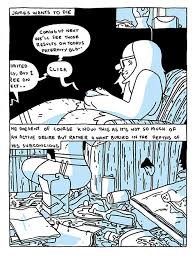Robyn Chapman continues to release interesting minicomics as part of her Paper Rocket Minicomics publishing concern, and Jason Bradshaw's Things Go Wrong is one of the most recent. Visually, it's in the same kind of rubbery, bigfoot style favored by artists like Sean Knickerbocker and Rusty Jordan. The characters are exaggerated and have odd dimensions; and the main character, James, takes up a lot of space on the page. This is by design: he fills up panels, bleeds over into other panels and essentially forces the reader to really examine him carefully from top to bottom. Though much of the story is done in a naturalistic fashion, Bradshaw's aim is to make the reader aware of the composition of each page. He wants them to see not just a character but also the process of what makes up the character: lines and shapes. The idea is to feel the way the character takes up space so that when he gets sick, the reader's reaction is a visceral one.
All of this is in a story about disease and depression. James is a sign painter and artist suffering from a debilitating parasite. This is a comic about how mental and physical illness can form a devastating synergy, with each affecting the other in turn. James is in pain, a feeling that initially inspires him to do paintings about this experience. However, given a chance at a cure, he opts not to take his medicine and stops doing anything but his work murals. He becomes suicidal by way of self-neglect, wanting to die but not being willing to actually kill himself. He's content to simply stop taking of himself in the hope that he'll be gone at some point. The blue wash for this comic speaks to that melancholy, as the reader is forced to watch him experience intense, unsettling pain along with losing control of his bowels. It's a resignation that's not just lacking a will to live, but rather it's almost a kind of self-punishment. James feels like he doesn't deserve to live because he has nothing to offer as an artist (and by extension, as a person).
The first issue ends with James at a low point, waiting for his death as he does nothing to take care of himself. That said, a future issue is mentioned, which means that this story is not yet over. I'll be curious to see how Bradshaw resolves this story and if James can find a way out. Notably, James has no friends or family to help him; that solitude is glaringly clear as he struggles through life. It's also a commentary on how the lack of human connection can accelerate depression and how our worst self-images and self-talk can bring us down. The slight touch of the grotesque in the drawings served to emphasize the ugliness that James felt.
Wednesday, March 6, 2019
Subscribe to:
Post Comments (Atom)






No comments:
Post a Comment